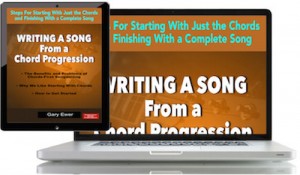Your song’s chords may seem wonderful to you, but it’s the melody that makes the song memorable.
_______________________
 As you’ll read below, chords-first songwriting comes with certain problems. But it can work, and here’s the eBook that shows you how. Includes several step-by-step methods for getting the most out of chords-first writing. Read more..
As you’ll read below, chords-first songwriting comes with certain problems. But it can work, and here’s the eBook that shows you how. Includes several step-by-step methods for getting the most out of chords-first writing. Read more..
_______________________
In a sense, the only problems worth mentioning in songwriting are the ones you can’t solve. If you find that songwriting keeps presenting difficulties for you, that’s normal. The solving of problems is the fun and challenging part of writing music.
So starting the writing of a song by developing a chord progression as a first step is fine, as long as you realize that there are potential problems. Among them, the most important one is that the melody you write to sit atop the progression can tend to have a wandering, shapeless quality.
If you’re writing instrumental music, there is a second potential problem: you can get so enamoured with your chords that you essentially neglect to write a melody at all, and so your instrumental tune winds up being four minutes of interesting chord changes, but little else.
Let’s deal with the first problem – the shapeless, wandering melody. It’s normal for melodies to imply chords, rather than the other way around. If you write a song melody that you really like, it’s probably good because it is implying chords that also work very well.
But chords that work well don’t necessarily imply one specific melody at all. Getting a good chord progression just means that you’ve paved a road for a melody, and for any chord progression there are hundreds and possibly thousands of melodies that might work.
There are lots of ways to develop melodies from chord progressions, and here’s a set of steps to try:
- Play your progression in many ways, changing the voicing of your chords each time. This means that if you’re a guitarist, play through your progression and try some at a higher voicing, some lower. If you’re a keyboardist, try chords placed high on the keyboard, especially making sure that the top note of each chord is the one you’re changing.
- Play your progression, changing the time signature each time. Try 4/4, 3/43, and then even some complex ones like 5/8 or 7/8.
- Play through your progression, changing the harmonic rhythm. This means changing how long you hold each chord. Try changing chords every 2, 4 or 8 beats. Then try a pattern of 4 and 2. Keep experimenting.
- Play through your progression using different performance styles. If you’re a guitarist, try some strumming, then finger picking, solid chords, arpeggiated chords… use your imagination.
- Play the first couple of chords and improvise a short melodic shape. Move on to the next chords, and see if you can sing a similar shape (or even the same one) over the next pair of chords.
That final step is an important one. One of the ways to prevent the aimless, wandering melody from happening is to use repetition wherever you can. Repetition is what makes melodies memorable, and most pop songs use it as a crucial feature.
Regarding instrumental music, melody is every bit as important as the melody of a song with a vocal line. But many songwriters who are trying their hand at writing instrumental tunes forget this important fact. When you are writing instrumentals, work on the melody as if someone is going to eventually sing it.
If you are trying to write good instrumentals, you need to give your listeners something to remember. No one sings chord progressions, and so the melody is vital to your song’s success.
– Gary Ewer (follow Gary on Twitter)
___________
 The Essential Secrets of Songwriting eBook Bundle packages are designed to get you writing the kind of songs you’ve always thought you could write. Take the frustration out of songwriting! Get TODAY’S DISCOUNT: Click here to learn more.
The Essential Secrets of Songwriting eBook Bundle packages are designed to get you writing the kind of songs you’ve always thought you could write. Take the frustration out of songwriting! Get TODAY’S DISCOUNT: Click here to learn more.











Pingback: Enhanced Voice Leading Through Chord Inversion | kurthartle
Pingback: 3 Crucial Whys & Hows to Get Out of Your Writing Comfort Zone | Studio 1215 news Blog